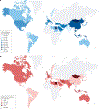Nonalcoholic steatohepatitis-related hepatocellular carcinoma: pathogenesis and treatment
- PMID: 36932227
- PMCID: PMC12165718
- DOI: 10.1038/s41575-023-00754-7
Nonalcoholic steatohepatitis-related hepatocellular carcinoma: pathogenesis and treatment
Abstract
Nonalcoholic fatty liver disease (NAFLD), including its more severe manifestation, nonalcoholic steatohepatitis (NASH), has a global prevalence of 20-25% and is a major public health problem. Its incidence is increasing in parallel to the rise in obesity, diabetes and metabolic syndrome. Progression from NASH to NASH-related hepatocellular carcinoma (HCC) (~2% of cases per year) is influenced by many factors, including the tissue and immune microenvironment, germline mutations in PNPLA3, and the microbiome. NASH-HCC has unique molecular and immune traits compared with other aetiologies of HCC and is equally prevalent in men and women. Comorbidities associated with NASH, such as obesity and diabetes mellitus, can prevent the implementation of potentially curative therapies in certain patients; nonetheless, outcomes are similar in patients who receive treatment. NASH-HCC at the early to intermediate stages is managed with surgery and locoregional therapies, whereas advanced HCC is treated with systemic therapies, including anti-angiogenic therapies and immune-checkpoint inhibitors. In this Review, we present the latest knowledge of the pathogenic mechanisms and clinical management of NASH-HCC. We discuss data highlighting the controversy over varying responses to immune-checkpoint inhibitors according to underlying aetiology and suggest that the future of NASH-HCC management lies in improved surveillance, targeted combination therapies to overcome immune evasion, and identifying biomarkers to recognize treatment responders.
© 2023. Springer Nature Limited.
Conflict of interest statement
Competing interests
J.M.L. received research support from Bayer HealthCare Pharmaceuticals, Eisai Inc., Bristol Myers Squibb, Boehringer-Ingelheim and Ipsen and consulting fees from Merck, Eli Lilly, Eisai Inc., Bayer HealthCare Pharmaceuticals, Bristol Myers Squibb, Exelixis, Ipsen, Genentech, Roche, Glycotest, Nucleix, Mina Alpha Ltd. and AstraZeneca. A.G.S. has served as a consultant or on advisory boards for Bayer, Eisai, Genentech, BMS, Exelixis, AstraZeneca, Wako Diagnostics, Exact Sciences, Roche, Glycotest, GRAIL and TARGET PharmaSolutions. H.B.E.-S. received research support from Glycotest, Gilead Sciences, Merck Sharp & Dohme BV and AbbVie. R.S.F. reports consulting fees from AstraZeneca, Bayer, CStone, BMS, Eisai, Exilixis, Eli Lilly, Pfizer, Merck, Roche/Genentech and Hengrui. S.L.F. is a consultant to 89 Bio, Amgen, Axcella Health, Blade Therapeutics, Bristol Myers Squibb, Can-Fite Biopharma, Casma Therapeutics, ChemomAb, Escient Pharmaceuticals, Forbion, Galmed, Gordian Biotechnology, Glycotest, Glympse Bio, Insitro, Morphic Therapeutics, North Sea Therapeutics, Novartis, Ono Pharmaceuticals, Pfizer Pharmaceuticals, Scholar Rock and Surrozen and has stock options (all less than 1% of company value) in Blade Therapeutics, Escient, Galectin, Galmed, Genfit, Glympse, Hepgene, Lifemax, Metacrine, Morphic Therapeutics, Nimbus, North Sea Therapeutics, Scholar Rock and Surrozen. All other authors declare no competing interests.
Figures



Similar articles
-
Hepatocellular Carcinoma in the Setting of Non-cirrhotic Nonalcoholic Fatty Liver Disease and the Metabolic Syndrome: US Experience.Dig Dis Sci. 2015 Oct;60(10):3142-8. doi: 10.1007/s10620-015-3821-7. Epub 2015 Aug 7. Dig Dis Sci. 2015. PMID: 26250831
-
Obesity, non-alcoholic fatty liver disease and hepatocellular carcinoma: current status and therapeutic targets.Front Endocrinol (Lausanne). 2023 Jun 8;14:1148934. doi: 10.3389/fendo.2023.1148934. eCollection 2023. Front Endocrinol (Lausanne). 2023. PMID: 37361533 Free PMC article. Review.
-
Molecular Mechanisms: Connections between Nonalcoholic Fatty Liver Disease, Steatohepatitis and Hepatocellular Carcinoma.Int J Mol Sci. 2020 Feb 23;21(4):1525. doi: 10.3390/ijms21041525. Int J Mol Sci. 2020. PMID: 32102237 Free PMC article. Review.
-
NAFLD-driven HCC: Safety and efficacy of current and emerging treatment options.J Hepatol. 2022 Feb;76(2):446-457. doi: 10.1016/j.jhep.2021.09.007. Epub 2021 Sep 20. J Hepatol. 2022. PMID: 34555422 Review.
-
Nonalcoholic Fatty Liver Disease/Nonalcoholic Steatohepatitis and Hepatocellular Carcinoma.Clin Liver Dis. 2018 Feb;22(1):201-211. doi: 10.1016/j.cld.2017.08.014. Clin Liver Dis. 2018. PMID: 29128057 Review.
Cited by
-
Redefining HCC Surveillance in India: A Call for Innovative and Inclusive Strategies.J Clin Exp Hepatol. 2024 Nov-Dec;14(6):101474. doi: 10.1016/j.jceh.2024.101474. Epub 2024 Jun 25. J Clin Exp Hepatol. 2024. PMID: 39108278 Review.
-
Elevated ALT/AST ratio as a marker for NAFLD risk and severity: insights from a cross-sectional analysis in the United States.Front Endocrinol (Lausanne). 2024 Aug 26;15:1457598. doi: 10.3389/fendo.2024.1457598. eCollection 2024. Front Endocrinol (Lausanne). 2024. PMID: 39253584 Free PMC article.
-
Meeting at the Crossroad between Obesity and Hepatic Carcinogenesis: Unique Pathophysiological Pathways Raise Expectations for Innovative Therapeutic Approaches.Int J Mol Sci. 2023 Sep 28;24(19):14704. doi: 10.3390/ijms241914704. Int J Mol Sci. 2023. PMID: 37834153 Free PMC article. Review.
-
Research landscape and frontiers of non-alcoholic steatohepatitis-associated hepatocellular carcinoma: a bibliometric and visual analysis.Front Pharmacol. 2023 Sep 12;14:1240649. doi: 10.3389/fphar.2023.1240649. eCollection 2023. Front Pharmacol. 2023. PMID: 37771721 Free PMC article.
-
MAFLD: an optimal framework for understanding liver cancer phenotypes.J Gastroenterol. 2023 Oct;58(10):947-964. doi: 10.1007/s00535-023-02021-7. Epub 2023 Jul 20. J Gastroenterol. 2023. PMID: 37470858 Free PMC article. Review.
References
-
- Sung H et al. Global cancer statistics 2020: GLOBOCAN estimates of incidence and mortality worldwide for 36 cancers in 185 countries. CA Cancer J. Clin. 71, 209–249 (2021). - PubMed
-
-
Llovet JM et al. Hepatocellular carcinoma. Nat. Rev. Dis. Primers 7, 6 (2021).
This review provides a comprehensive up-to-date overview of the epidemiology, pathogenesis and management of HCC.
-
-
- Anstee QM, Reeves HL, Kotsiliti E, Govaere O & Heikenwalder M From NASH to HCC: current concepts and future challenges. Nat. Rev. Gastroenterol. Hepatol. 16, 411–428 (2019). - PubMed
-
- Chalasani N et al. The diagnosis and management of nonalcoholic fatty liver disease: practice guidance from the American Association for the Study of Liver Diseases. Hepatology 67, 328–357 (2018). - PubMed
-
-
Huang DQ, El-Serag HB & Loomba R Global epidemiology of NAFLD-related HCC: trends, predictions, risk factors and prevention. Nat. Rev. Gastroenterol. Hepatol. 18, 223–238 (2021).
This manuscript thoroughly analyses the global epidemiology, projections and risk factors for NAFLD-related HCC.
-
Publication types
MeSH terms
Substances
Grants and funding
LinkOut - more resources
Full Text Sources
Medical

